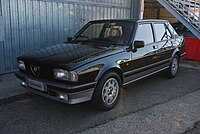
Alfa Romeo Automobiles S.p.A. is an Italian carmaker known for its sports-oriented vehicles, strong auto racing heritage, and iconic design. Headquartered in Turin, Italy, it is a subsidiary of Stellantis Europe and one of 14 brands of multinational automotive company Stellantis.

Zagato is a coachbuilding company founded by Ugo Zagato in 1919. The design center of the company is located in Terrazzano, a village near Rho, Lombardy, Italy.
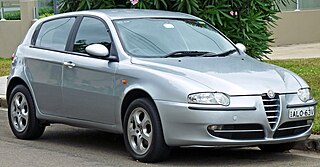
The Alfa Romeo 147 is a small family car produced by the Italian automaker Alfa Romeo from 2000 to 2010. The 147 was voted European Car of the Year in 2001.
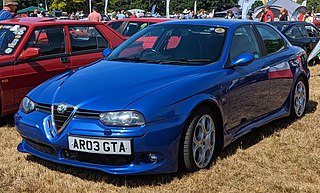
The Alfa Romeo 156 is a compact executive car produced by the Italian automobile manufacturer Alfa Romeo. It was introduced at the 1997 Frankfurt Motor Show as the replacement for the Alfa Romeo 155. The 156 received a positive reception and in the following year went on to win the 1998 European Car of the Year award. The 156 saloon was discontinued in Europe late in 2005, while the Q4 Crosswagon continued in production until the end of 2007.
ATS is an Italian automotive constructor. It once had a racing team that operated between 1963 and 1965, formed after the famous "Palace Revolution" at Ferrari.

The Alfa Romeo 155 is a compact executive car produced by Italian automobile manufacturer Alfa Romeo between 1992 and 1998. It was unveiled in January 1992 at Barcelona, with the first public launch in March 1992, at the Geneva Motor Show. A total of 195,526 units were made before it was replaced by the 156.

The Alfa Romeo Montreal is a sports car produced by the Italian automobile manufacturer Alfa Romeo from 1970 to 1977.

The Alfa Romeo GTA is a coupé automobile manufactured by the Italian manufacturer Alfa Romeo from 1965 to 1971. It was made for racing (Corsa) and road use (Stradale).
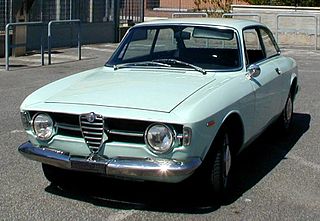
The Alfa Romeo 105 and 115 series coupés are a range of cars made by the Italian manufacturer Alfa Romeo from 1963 until 1977, based on a shortened floorpan from the Giulia saloon. They were the successors to the Giulietta Sprint coupé.
The Alfa Romeo Tipo 33 was a sports racing prototype raced by the Alfa Romeo factory-backed team between 1967 and 1977. These cars took part for Sport Cars World Championship, Nordic Challenge Cup, Interserie and CanAm series. A small number of road going cars were derived from it in 1967, called Alfa Romeo 33 Stradale.

The Alfa Romeo 33 Stradale is a mid-engine sports car built by Italian automobile manufacturer Alfa Romeo. It was the fastest commercially available car for the standing kilometer upon its introduction. 18 examples were produced between 1967 and 1969. "Stradale" is a term often used by Italian car manufacturers to indicate a street-legal version of a racing car; indeed the 33 Stradale was derived from the Tipo 33 sports prototype. Built in an attempt by Alfa Romeo to make some of its racing technology available to the public, it was also the most expensive automobile for sale to the public in 1968 at US$17,000.

Carlo Chiti was an Italian racing car and engine designer best known for his long association with Alfa Romeo's racing department. He also worked for Ferrari and was involved in the design of the Ferrari 156 Sharknose car, with which Phil Hill won the 1961 championship.

During its history, Alfa Romeo has competed successfully in many different categories of motorsport, including Grand Prix motor racing, Formula One, sportscar racing, touring car racing and rallies. They have competed both as a constructor and an engine supplier, via works entries and private entries. The first racing car was made in 1913, three years after the foundation of A.L.F.A., the 40/60 HP had 6-litre straight-4 engine. Alfa Romeo quickly gained a good name in motorsport and gave a sporty image to the whole marque.
Alfa Corse is Alfa Romeo's factory racing team. Throughout the years, Alfa Corse has competed in various forms of motorsport, from Grand Prix motor racing to touring car racing.
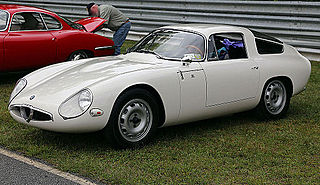
The Alfa Romeo Giulia TZ was a sports car and racing car manufactured by Alfa Romeo from 1963 to 1967. It replaced the Giulietta SZ. In 2011, the name was reduced from Giulia TZ to TZ in the new TZ3 model.
Italian motor manufacturer Alfa Romeo has participated multiple times in Formula One. The brand has competed in motor racing as both a constructor and engine supplier sporadically between 1950 and 1987, and later as a commercial partner between 2015 and 2023. The company's works drivers won the first two World Drivers' Championships in the pre-war Alfetta: Nino Farina in 1950 and Juan Manuel Fangio in 1951. Following these successes, Alfa Romeo withdrew from Formula One.
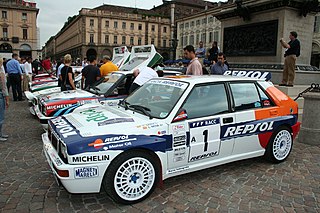
Jolly Club was an Italian motor racing team, which competed in the World Rally Championship, the Sportscar World Championship, the European Touring Car Championship, the BPR Global GT Series, and briefly in the Formula One World Championship, along with several domestic championships, it was mainly connected to brands like Alfa Romeo, Lancia and Ferrari. It was created in 1957 in Milan by idea of Mario Angiolini, the team won several championships. The team's main sponsor was Italian gaming totalizer Totip so the cars used orange and green colors on their livery until the World Rally Championship 1996. They also had a lengthy association with alcoholic beverage company Martini & Rossi.
Sergio Limone is an Italian automobile engineer. He has carried out numerous sports car projects for the Fiat Group, including the Lancia Rally 037, Lancia Delta S4 and Lancia Delta for FIA World Rally Championship, and the Alfa Romeo 155 and Alfa Romeo 156 Touring cars.

Alfa Romeo has made three 8-cylinder Grand Prix racing engines designed for both Formula One and sports car racing; in both inline and V engine configurations. Their first was the supercharged 158/159, a straight-eight engine, with the 1.5 L engine configuration imposed by the FIA for forced induction engines, in 1950. After a 20-year gap, their second engine was the Tipo 33 engine, a 3-liter naturally-aspirated V8 engine, in 1970. Their third and final engine was the turbocharged 890T V8 engine in 1983, which was used by both Alfa Romeo until 1985, and Osella until 1988, until Alfa Romeo eventually pulled out of F1 that same year.
Alfa Romeo made a series of 2.1-litre to 3.0-litre, naturally-aspirated and turbocharged, V-12 and flat-12, Grand Prix and Sports car racing engines designed for Formula One, the World Sportscar Championship, Can-Am, the Nordic Challenge Cup, and Interserie; starting in 1973, with their Alfa Romeo 33TT12 Group 5 sports car. This was followed by the twin-turbocharged Alfa Romeo 33SC12 Group 6 engine in 1976, and shortly after, Brabham as an engine supplier in 1976; before entering Formula One themselves in 1979. Their first was a Carlo Chiti-designed Alfa Romeo flat-12 engine which had been used earlier in the Alfa Romeo 33TT12 and 33SC12 sports cars. In 1976 this engine was supplied to Brabham and the deal continued until 1979. The engine was dubbed the 115-12, and was a 180° V12 engine; essentially making it a flat-12 engine. Their second 12-cylinder engine, dubbed the 1260, debuted at the 1979 Italian Grand Prix. This time, the engine configuration was a conventional 60° V-12, rather than a flat layout.




